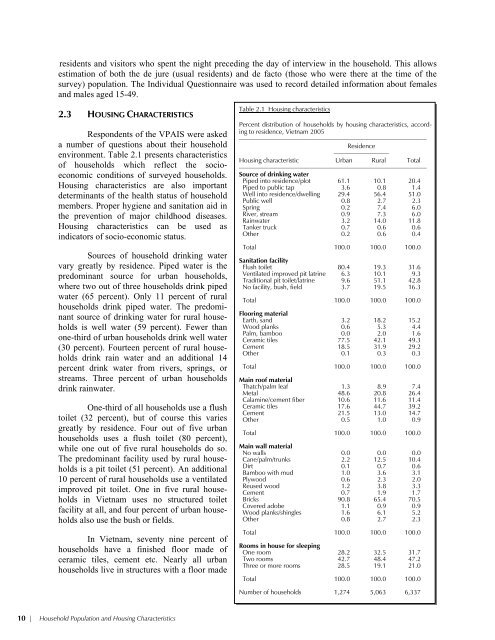Vietnam Population and AIDS Indicator Survey 2005 ... - Measure DHS
Vietnam Population and AIDS Indicator Survey 2005 ... - Measure DHS
Vietnam Population and AIDS Indicator Survey 2005 ... - Measure DHS
Create successful ePaper yourself
Turn your PDF publications into a flip-book with our unique Google optimized e-Paper software.
esidents <strong>and</strong> visitors who spent the night preceding the day of interview in the household. This allows<br />
estimation of both the de jure (usual residents) <strong>and</strong> de facto (those who were there at the time of the<br />
survey) population. The Individual Questionnaire was used to record detailed information about females<br />
<strong>and</strong> males aged 15-49.<br />
2.3 HOUSING CHARACTERISTICS<br />
Respondents of the VPAIS were asked<br />
a number of questions about their household<br />
environment. Table 2.1 presents characteristics<br />
of households which reflect the socioeconomic<br />
conditions of surveyed households.<br />
Housing characteristics are also important<br />
determinants of the health status of household<br />
members. Proper hygiene <strong>and</strong> sanitation aid in<br />
the prevention of major childhood diseases.<br />
Housing characteristics can be used as<br />
indicators of socio-economic status.<br />
Sources of household drinking water<br />
vary greatly by residence. Piped water is the<br />
predominant source for urban households,<br />
where two out of three households drink piped<br />
water (65 percent). Only 11 percent of rural<br />
households drink piped water. The predominant<br />
source of drinking water for rural households<br />
is well water (59 percent). Fewer than<br />
one-third of urban households drink well water<br />
(30 percent). Fourteen percent of rural households<br />
drink rain water <strong>and</strong> an additional 14<br />
percent drink water from rivers, springs, or<br />
streams. Three percent of urban households<br />
drink rainwater.<br />
One-third of all households use a flush<br />
toilet (32 percent), but of course this varies<br />
greatly by residence. Four out of five urban<br />
households uses a flush toilet (80 percent),<br />
while one out of five rural households do so.<br />
The predominant facility used by rural households<br />
is a pit toilet (51 percent). An additional<br />
10 percent of rural households use a ventilated<br />
improved pit toilet. One in five rural households<br />
in <strong>Vietnam</strong> uses no structured toilet<br />
facility at all, <strong>and</strong> four percent of urban households<br />
also use the bush or fields.<br />
In <strong>Vietnam</strong>, seventy nine percent of<br />
households have a finished floor made of<br />
ceramic tiles, cement etc. Nearly all urban<br />
households live in structures with a floor made<br />
Table 2.1 Housing characteristics<br />
Percent distribution of households by housing characteristics, according<br />
to residence, <strong>Vietnam</strong> <strong>2005</strong><br />
––––––––––––––––––––––––––––––––––––––––––––––––––––––––––<br />
Residence<br />
–––––––––––––––––<br />
Housing characteristic Urban Rural Total<br />
––––––––––––––––––––––––––––––––––––––––––––––––––––––––––<br />
Source of drinking water<br />
Piped into residence/plot 61.1 10.1 20.4<br />
Piped to public tap 3.6 0.8 1.4<br />
Well into residence/dwelling 29.4 56.4 51.0<br />
Public well 0.8 2.7 2.3<br />
Spring 0.2 7.4 6.0<br />
River, stream 0.9 7.3 6.0<br />
Rainwater 3.2 14.0 11.8<br />
Tanker truck 0.7 0.6 0.6<br />
Other 0.2 0.6 0.4<br />
Total 100.0 100.0 100.0<br />
Sanitation facility<br />
Flush toilet 80.4 19.3 31.6<br />
Ventilated improved pit latrine 6.3 10.1 9.3<br />
Traditional pit toilet/latrine 9.6 51.1 42.8<br />
No facility, bush, field 3.7 19.5 16.3<br />
Total 100.0 100.0 100.0<br />
Flooring material<br />
Earth, s<strong>and</strong> 3.2 18.2 15.2<br />
Wood planks 0.6 5.3 4.4<br />
Palm, bamboo 0.0 2.0 1.6<br />
Ceramic tiles 77.5 42.1 49.3<br />
Cement 18.5 31.9 29.2<br />
Other 0.1 0.3 0.3<br />
Total 100.0 100.0 100.0<br />
Main roof material<br />
Thatch/palm leaf 1.3 8.9 7.4<br />
Metal 48.6 20.8 26.4<br />
Calamine/cement fiber 10.6 11.6 11.4<br />
Ceramic tiles 17.6 44.7 39.2<br />
Cement 21.5 13.0 14.7<br />
Other 0.5 1.0 0.9<br />
Total 100.0 100.0 100.0<br />
Main wall material<br />
No walls 0.0 0.0 0.0<br />
Cane/palm/trunks 2.2 12.5 10.4<br />
Dirt 0.1 0.7 0.6<br />
Bamboo with mud 1.0 3.6 3.1<br />
Plywood 0.6 2.3 2.0<br />
Reused wood 1.2 3.8 3.3<br />
Cement 0.7 1.9 1.7<br />
Bricks 90.8 65.4 70.5<br />
Covered adobe 1.1 0.9 0.9<br />
Wood planks/shingles 1.6 6.1 5.2<br />
Other 0.8 2.7 2.3<br />
Total 100.0 100.0 100.0<br />
Rooms in house for sleeping<br />
One room 28.2 32.5 31.7<br />
Two rooms 42.7 48.4 47.2<br />
Three or more rooms 28.5 19.1 21.0<br />
Total 100.0 100.0 100.0<br />
Number of households 1,274 5,063 6,337<br />
10 | Household <strong>Population</strong> <strong>and</strong> Housing Characteristics








![Obtaining Informed Consent for HIV Testing [QRS4] - Measure DHS](https://img.yumpu.com/49850117/1/190x245/obtaining-informed-consent-for-hiv-testing-qrs4-measure-dhs.jpg?quality=85)








